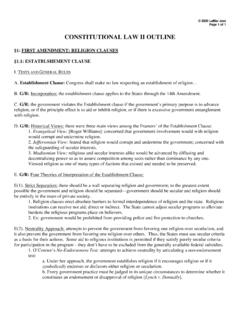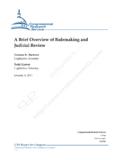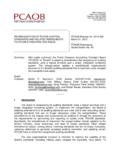Transcription of ADMINISTRATIVE LAW OUTLINE §1: OVERVIEW OF THE ...
1 1 ADMINISTRATIVE LAW OUTLINE 1: OVERVIEW OF THE ADMINISTRATIVE process : The Fourth Branch of Government I. INTRODUCTION A. Generally: the purpose and function of ADMINISTRATIVE law in a constitutional system which does not provide for ADMINISTRATIVE agencies: 1. The power of ADMINISTRATIVE agencies is inferred from Congressional and Presidential authority over ADMINISTRATIVE agencies. 2. The purpose of ADMINISTRATIVE agencies is to make law, Congress does not make most laws; however the power to make law is delegated to ADMINISTRATIVE agencies by Congress. a. Delegation: is the key word, Congress delegates its power to promulgate rules to ADMINISTRATIVE agencies because they are experts in specialized fields which make them better equipped to make specialized laws. 3. Policy: the policies behind ADMINISTRATIVE laws are: a. Congress does not have (a) the time, (b) expertise, or (c) people to regulate all aspects of American life which need to be regulated.
2 B. Expertise, time, and capacity are the main reasons for ADMINISTRATIVE law. c. Fairness: the goal of ADMINISTRATIVE law is to have agencies work in a fair way; however, it is not always possible to treat similarly situated people the same. i. Thus, a lot of ADMINISTRATIVE law is designing structures and procedures to ensure fairness. When the public is involved in ADMINISTRATIVE law, the process is generally more fair. 4. Elements of Fairness: there are three main elements of fairness that the Courts try and promote in ADMINISTRATIVE law: a. Reviewability: review by the court is a safeguard that makes regulation by agencies more fair. b. Consistency: equal protection and due process requirements establish procedures for making ADMINISTRATIVE law more consistent, and hence, more fair. c. Efficiency: is part of the task of ADMINISTRATIVE agencies, and the more efficient the system is, the more fair it is to participants in the system.
3 B. 4th Branch of Government: the ADMINISTRATIVE branch is referred to as the fourth branch of government. There are various kinds of ADMINISTRATIVE agencies: 1. Executive Agencies: consist mostly of cabinet departments (such as the State and Treasury departments) and their components, such as the Food and Drug Administration (FDA) and the Social Security Administration, both within the department of Health and Human Services. a. There are some executive agencies that are not located within any department, such as the EPA. 2. Independent Regulatory Agencies: are agencies which are not subject to direct presidential controls. a. Examples: ICC, Federal Reserve Board, FTC, NRLB, and FCC. 3. It is difficult to categorize agencies for separation of powers purposes because modern ADMINISTRATIVE the functions of all three branches of government: a. formulate rules; 2b. adjudicate cases; and c. prosecute actions and violations of the rules.
4 C. Policy Behind ADMINISTRATIVE Law: the increase in the size of the nation and government has required ADMINISTRATIVE agencies to play a more prominent role in the structure of government since the New Deal Era. 1. The traditional three branches of government did not have enough people to regulate the many facets of American life; 2. Expertise; 3. In ADMINISTRATIVE law the government should try and strive to: a. Ensure fairness, consistency, and efficient governmental functioning. b. This is achieved by: i. Public involvement, which takes the forms of knowledge and participation; ii. Judicial review, because the courts have an interest in judicial review, however, judicial review of every agency action would be impracticable. II. ADMINISTRATIVE PROCEDURE ACT OF 1946 A. G/R: an ADMINISTRATIVE agency draws its substantive and procedural power from the organic legislation that creates it. 1.
5 The APA is the prominent and important piece of legislation concerning federal ADMINISTRATIVE agencies. a. States have their own APA s modeled after the federal APA. b. The basic structure of the APA is the same today as it was in 1946 with more procedural safeguards. B. G/R: APA Definitions: [ 551]: the definitional section is one of the most important sections of the APA, for the purposes of the APA the following definitions apply: 1. Agency: means each authority of the US government, whether or not it is within or subject to review by another agency. a. An agency does not include: i. Congress; ii. the Courts of the US; iii. the governments, territories, or possessions of the 2. Rule: means the whole or part of an agency statement of (a) general or particular applicability; and (b) future effect, designed to implement, interpret, or prescribe law or policy. Rules include: a. Any law or policy describing the organization, procedure, or practice requirements of an agency; b.
6 The approval or prescription for future rates, wages, corporate, or financial structures or reorganizations. c. Rules deal with lawmaking/rulemaking and have future effect. 3. Rulemaking: is the agency process for formulating, amending, or repealing a rule. 4. Order: means the whole or part of a final disposition of an agency matter other than rulemaking but including licensing. a. Orders deal with adjudication and apply to past actions. 5. Adjudication: means agency process for the formulation of an order. 6. Agency Proceeding: means an agency process of rulemaking, adjudication, or licensing. 37. Agency Action: includes the whole or part of an agency rule, order, license, sanction, relief, or the denial thereof, or a failure to act. 8. Ex Parte Communication: means oral or written communication not on the public record with respect to which reasonable prior notice to all parties is not given. C.
7 G/R: Adjudication under the APA: [ 554-557]: the APA sections for adjudication apply in every case of adjudication required by statute to determine on the record after opportunity for an agency hearing with certain exceptions. 1. In other words, the APA is a default statute; that is, absent a statutory command in the organic legislation the APA adjudication procedures apply. 2. The APA never requires adjudication by its own force; it just applies when other law (statutory or constitutional) requires it to apply. 3. Agencies still perform prosecutorial and adjudicative functions, however there are more built in procedures: a. Hearing Examiners, ADMINISTRATIVE Law Judges (ALJs) hear the case and are independent officers not subject to agency control of salary, promotion, and tenure. b. In the hearing process ; the Agency has the burden of proof and the taking of official notice is fairly regularized. e.
8 ADMINISTRATIVE adjudications broadly resemble judicial trials without a jury. They share with trials the compilation of a record to provide the exclusive basis for decision. They are also open to the public. D. G/R: Agency Rulemaking under the APA: [ 553]: the most distinctive ADMINISTRATIVE procedure is rulemaking. There are three kinds of rules: substantive, interpretative, and procedural. 1. 553(c): Substantive Rules: have the force of law because they are based on statutory authority to adopt them. The APA s generally applicable procedure for adopting substantive rules requires only: a. that an agency publish notice of a proposed rule; b. afford the public an opportunity to comment on the proposed rule; and c. accompany the final rule with a concise statement of its basis and purpose. 1(a). There are two types of substantive agency rules: a. Informal Rulemaking: is the procedure that most agency laws take and it only requires compliance with 553(c) to take effect.
9 Informal rulemaking does not require an exclusive record for decision. b. Formal Rulemaking: occurs in relatively few instances when a statute specifically requires a rule to be based on the record of an agency hearing [ 553(c)]. i. Formal rulemaking tends to resemble adjudication, it requires an exclusive record for its decision, although there is provision for some flexibility in this regard [ 556(d)]. 2. Interpretive Rules: say how an agency will interpret its statutory mandate, to guide both the staff and affected persons in such important matters as enforcement of policy. a. Interpretive rules range form informally developed policy statements announced through press releases to authoritative rulings issued only after interested persons are given notice and opportunity to comment. 3. Procedural Rules: identify the agency s organization, describe its method of operation, and spell out the requirements of its practice for rulemaking and adjudicative hearings.
10 4a. These are largely housekeeping rules, however, they are binding on the agency in the sense that an agency decision will usually be reversed if a regulated party can show injury due to an agency s noncompliance with its own rules. E. G/R: Judicial Review of ADMINISTRATIVE Action: Marbury v. Madison established judicial review as a fundamental constitutional precept. With respect to ADMINISTRATIVE law Marbury has three fundamental principles: 1. courts can review executive action only when that review is validly authorized; 2. the functions of an administrator such as the Secretary of State are partly political and partly controlled by law; and 3. the Supreme Court (or judiciary) determines whether an enforceable legal right is a political question. F. G/R: Judicial Review under the APA: [ 701-706] the APA for the most part codified but did not expand preexisting law on the availability and nature of judicial review of federal agency action.




